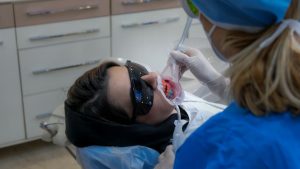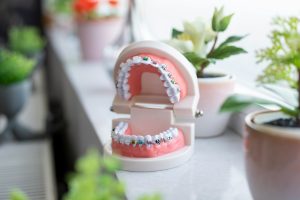Gum disease affects nearly half of all adults globally—and many don’t even realize it until the damage is advanced. From bleeding gums to tooth loss, the consequences can be serious, yet largely preventable. This guide uncovers three everyday lifestyle changes that play a vital role in maintaining healthy gums: your diet, your hydration habits, and your dental visit routine. You’ll discover how what you eat can either fuel or fight gum disease, why drinking more water—especially after meals—is more powerful than you think, and how regular dental care like deep scaling or root cleaning keeps gum disease in check. Could your daily habits be silently damaging your gums? Read on to find out.
What Causes Gum Disease in the First Place?
Gum disease, or periodontal disease, is one of the most common chronic oral health issues worldwide—and it’s largely preventable. In 2025, it’s estimated that over 50% of adults globally experience some form of gum disease, from mild gingivitis to advanced periodontitis (World Health Organization). In Singapore, similar trends are reported by the Health Promotion Board, where lifestyle and systemic health factors continue to drive prevalence. To prevent or reverse gum disease, it’s essential to first understand what causes it at the root.
Primary Cause: Plaque and Bacterial Biofilm
The earliest and most significant cause of gum disease is dental plaque. This sticky, colourless film of bacteria constantly forms on your teeth and along the gumline. When plaque is not effectively removed by brushing and flossing, it hardens into tartar, which irritates the gums and creates a breeding ground for more bacteria. This results in inflammation, commonly known as gingivitis—the first stage of gum disease.
When Inflammation Turns Destructive
If gingivitis is left untreated, it can progress to periodontitis. In this stage, toxins from bacteria and the body’s own immune response begin to break down the bone and connective tissue that hold teeth in place. The gums pull away from the teeth, forming deep pockets that trap even more bacteria. This is when professional intervention like root cleaning or deep scaling and root planing becomes necessary to clean beneath the gumline and prevent further destruction.
Lifestyle Factors That Increase Risk
Several lifestyle habits significantly increase the risk of developing or accelerating gum disease:
| Risk Factor | Impact on Gum Health |
|---|---|
| Smoking | Reduces oxygen in the blood, slows gum healing, masks bleeding (a key symptom) |
| Alcohol | Frequent consumption is associated with alcohol gum disease, dry mouth, and poor oral hygiene |
| Poor Oral Hygiene | Allows plaque and tartar to accumulate, leading to gum inflammation |
| Stress | Weakens the immune system, reducing the body’s ability to fight off infection |
| Nutrition Deficiencies | Lack of essential nutrients like Vitamin C impairs gum tissue repair |
Source: Health Promotion Board Singapore, ADA.org, WHO Oral Health Report 2025
Underlying Medical Conditions
Certain health conditions make individuals more prone to gum infections. Diabetes, for example, lowers the body’s ability to fight infections and can make gum disease more severe. Similarly, immune disorders and hormonal changes during pregnancy or menopause may also increase susceptibility. In Singapore, the Ministry of Health encourages regular dental checkups for high-risk groups such as diabetics and seniors.
When to Seek Professional Help
Early signs of gum disease—such as swollen gums, bleeding during brushing, persistent bad breath, or sensitivity—should not be ignored. If symptoms progress to loose teeth or receding gums, a dentist may recommend advanced periodontal treatment such as root cleaning or deep scaling and root planing. These procedures are essential to remove bacterial buildup from beneath the gumline and help gums reattach to the tooth surface.
Understanding the root causes of gum disease empowers individuals to make smarter daily choices. From oral hygiene and diet to lifestyle habits and medical conditions, multiple factors play a role. Addressing these proactively is the first step toward long-term gum health.
Gum Disease and Diabetes: What’s the Connection?
The link between gum disease and diabetes is not just a coincidence—it’s a well-established two-way relationship that has critical implications for overall health. In 2025, nearly 1 in 9 Singaporeans is living with diabetes, according to the Ministry of Health, and many are unaware that poor blood sugar control can significantly increase the risk of periodontal disease. At the same time, untreated gum disease can make it more difficult to manage blood glucose levels, creating a vicious cycle of inflammation and systemic health issues.
How Diabetes Increases Gum Disease Risk
Individuals with diabetes, especially those with poorly managed blood glucose, are more susceptible to infections, including those affecting the gums. Elevated sugar levels in saliva provide an ideal environment for bacteria to thrive, contributing to plaque formation. Moreover, diabetes weakens blood vessels and slows circulation, making it harder for the body to deliver nutrients and remove waste from gum tissue, which delays healing and increases the risk of periodontal breakdown.
How Gum Disease Impacts Blood Sugar Control
On the flip side, chronic inflammation from gum disease can increase insulin resistance and worsen glycaemic control. Bacteria from infected gums can enter the bloodstream, triggering an inflammatory response that interferes with the body’s ability to regulate blood sugar. This makes managing diabetes more complex and raises the risk of complications such as cardiovascular disease, kidney damage, and nerve issues.

Warning Signs to Watch For
People with diabetes should be especially vigilant about oral health symptoms. Common signs of gum disease include:
- Red, swollen, or tender gums
- Bleeding while brushing or flossing
- Persistent bad breath
- Receding gums or loose teeth
- Changes in bite or fit of dentures
What Can Diabetics Do to Protect Their Gums?
Prevention and early intervention are key. Diabetics should maintain optimal blood glucose levels and commit to excellent oral hygiene. Regular dental visits—every 6 months or more frequently if advised—are crucial. Dentists may recommend targeted cleanings or even more advanced procedures like scaling and root planing in moderate to severe cases.
| Preventive Measures | How It Helps |
|---|---|
| Blood Sugar Control | Reduces infection risk and inflammation in gum tissues |
| Twice-Daily Brushing & Flossing | Removes plaque and prevents bacterial buildup |
| Routine Dental Visits | Allows early detection and treatment of gum disease |
| Antimicrobial Mouthwash | Helps reduce bacteria in the mouth |
| Smoking Cessation | Improves healing and reduces inflammation |
Local Guidelines and Support in Singapore
In Singapore, the Ministry of Health and the Health Promotion Board have integrated oral health checks into national diabetes management programmes. The “War on Diabetes” initiative encourages regular dental screenings as part of chronic disease care. Subsidised dental services are available through CHAS (Community Health Assist Scheme), making periodontal care more accessible for individuals managing diabetes.
In summary, the connection between gum disease and diabetes is strong, reciprocal, and impactful. Managing one condition effectively requires proactive attention to the other. For individuals living with diabetes, protecting gum health is not just about preventing tooth loss—it’s a vital part of maintaining long-term overall health.
Watch What You Eat—The Link Between Diet and Gum Disease
Diet plays a pivotal but often underestimated role in oral health—and it can either guard against or feed into the processes that lead to gum disease. While brushing, flossing, and regular checkups are essential, what you eat every day influences the bacterial balance around your gums, supports tissue repair, and determines whether your gums remain resilient or succumb to inflammation and recession.
How Foods Contribute to Gum Health or Harm
Certain foods promote bacterial overgrowth and acidity, weakening your gum‑tooth interface, while others supply nutrients that help maintain healthy gingiva and block inflammation. In Singapore, where refined sugars and acidic drinks are commonly consumed, patients often unknowingly tip the balance in favour of harmful bacteria. Dental gum-friendly choices can shift that balance back.
For example, sticky sweets, soft drinks, and high-glycaemic snacks feed oral bacteria, accelerating plaque formation, which then triggers inflammation of the gum tissues. Over time, chronic irritation can lead to the formation of deeper pockets and structural damage. On the flip side, nutrient-dense foods support collagen formation, immune response, and repair mechanisms essential to gum resilience.
Key Nutrients That Support Gum Health
To nourish gums that are “good for your teeth,” focus on building a diet rich in:
- Vitamin C: supports collagen and helps prevent gum inflammation.
- Omega‑3 fatty acids: help moderate inflammatory responses in gum tissue.
- Calcium, phosphorus & magnesium: maintain mineral balance in adjacent bone and tooth roots.
- Antioxidants & polyphenols: found in green tea, berries, and leafy vegetables, these help neutralize oxidative stress around the gumline.
Crunchy fibrous foods like apples, carrots, and celery also act as natural cleansers, stimulating saliva flow and gently scrubbing away soft debris before it gets lodged at the canker sore gum line or gum crevices. These benefits are supported in Singapore studies and oral health guidelines.
Diet Patterns to Avoid or Limit
To reduce the burden on your gums, try to limit:
- Refined sugars & sticky sweets: They linger and fuel bacterial acid production.
- Frequent snacking: Each snack may lower your mouth’s pH, promoting demineralization and bacterial shifts.
- Acidic drinks & citrus overload: While fruits are beneficial for nutrients, their acid content can irritate sensitive gums if consumed excessively.
Sample Gum‑Friendly Diet Plan
Here’s a simple comparison of choices that harm vs. choices that help your gums:
| Meal / Snack | Harmful Choice | Gum‑Friendly Alternative |
|---|---|---|
| Morning snack | Sweetened biscuit or doughnut | Apple slices + unsalted nuts |
| Lunch beverage | Soda or sugary iced tea | Water, or unsweetened green tea |
| Afternoon snack | Sticky candy / gummy | Carrot sticks or celery with hummus |
| Dessert | Citrus tart or lemon dessert | Yoghurt + fresh berries |
Based on food recommendations for oral and gum health.
Practical Tips for Everyday Eating in Singapore
• Rinse or chew sugar-free gum after consuming acidic or sugary local foods like bubble tea or hawker desserts.
• Swap white rice or plain noodles for whole grains (e.g. brown rice, wholegrain variants) to slow sugar release and reduce microbial fuel.
• Add leafy greens like kale, spinach, or local greens (e.g. kai lan) to local dishes to boost vitamin C and fiber.
• Use herbs and spices (e.g. turmeric, green tea extracts) that may help control oral microbial growth.
• Space out sugary or acidic treats—don’t “graze” continuously—and when you indulge, brush or rinse soon after.
Key Takeaways
- Your diet can tip the balance between thriving oral bacteria and harmful ones—impacting the risk and progression of gum disease.
- Choose nutrient-rich, fibrous, antioxidant foods that support gum tissue—i.e. those “good for your teeth.”
- Limit refined sugars, frequent snacking, and acidic beverages that inflame gums and erode enamel.
- Make small, consistent swaps in local meals—because in Singapore’s vibrant food culture, smart choices can make all the difference.
Paying attention to what you eat helps safeguard your gums from the inside out. In the next section, we’ll explore how hydration and simple rituals tie into preventing gum disease and protecting your oral tissues over time.
Drink More Water, Especially After Meals Helps Prevent Gum Disease
Drinking water might seem like a minor habit, but it plays a surprisingly powerful role in oral hygiene—especially in helping to prevent gum disease. In Singapore’s warm and humid climate, staying hydrated is already essential, but when done strategically—such as after meals—it can have direct and meaningful effects on your gum health.
Why Hydration Matters for Gum Health
Water helps cleanse the mouth, neutralise acids, and wash away food debris and bacteria that could otherwise accumulate along the gum line. Without adequate hydration, food particles linger longer, feeding harmful bacteria that contribute to plaque build-up and eventually, gums separating from teeth. According to the Singapore Dental Association, consistent hydration supports saliva production, which is the body’s natural defence mechanism against oral pathogens.
Saliva: Your Natural Shield
Saliva is often overlooked, but it plays a critical role in protecting gums. It contains enzymes and proteins that combat bacteria, and it helps maintain a balanced pH level in the mouth. When you drink water—especially after eating—you stimulate saliva flow, which helps clean the mouth and deliver minerals to weakened enamel and gum tissues.
Timing Matters: Why Post-Meal Water Is Key
After meals, especially those rich in carbohydrates or sugars, your mouth becomes a breeding ground for acid-forming bacteria. This acidic environment can weaken the gum-tooth connection. Drinking water post-meal can rinse away sugars, reduce acidity, and disrupt early plaque formation before it turns into hardened tartar that exacerbates gum disease.
Plain Water vs. Other Beverages
While fruit juices, coffee, and milk teas are popular in Singapore, they can leave residues that contribute to bacterial growth and gum irritation. Water, on the other hand, is neutral and effective at rinsing without leaving behind sugars or acids. It’s also worth noting that bottled waters with added flavours often contain citric acid or sweeteners that can worsen gum sensitivity.
| Beverage | Effect on Gums | Recommendation |
|---|---|---|
| Plain Water | Hydrates mouth, flushes bacteria, neutralises acid | Drink freely, especially after meals |
| Sugary Drinks (e.g., Bubble Tea) | Feeds bacteria, promotes plaque, dries mouth | Limit, rinse with water afterwards |
| Coffee/Tea | May stain teeth and dehydrate | Drink with water on the side |
| Alcohol | Drying effect, worsens gums separating from teeth | Minimise, always hydrate after |
Source: Singapore Dental Association, 2025 Oral Health Guidelines
How Much Water Should You Drink Daily?
In Singapore, the Health Promotion Board recommends an average of 1.5 to 2 litres of water daily for adults (HPB, 2025), though needs may increase with activity, heat, or medical conditions. For oral health specifically:
- Drink water after every meal and snack.
- Keep a bottle on your desk or bag to sip throughout the day.
- If consuming acidic or sweet drinks, rinse with water afterward.
- Consider fluoride-enhanced water for added enamel support (check with your dental provider).
What Happens If You Don’t Hydrate Enough?
Dehydration reduces saliva flow, allowing bacterial colonies to flourish along the gumline. This can lead to early signs of gum disease like redness, bleeding, and bad breath. In chronic cases, the gums may begin separating from the teeth, forming periodontal pockets that trap more bacteria and require advanced treatment such as scaling or gum surgery.
Hydration as a Daily Habit to Protect Your Gums
Unlike brushing or flossing, drinking water doesn’t require extra time—it simply involves being mindful and consistent. Here are ways to make it a habit:
- Pair your meals with a full glass of water instead of sugary beverages.
- Use reminders or mobile hydration apps to keep you on track.
- Keep reusable water bottles at work and home to encourage easy access.
- Choose cooling, local-infused waters (e.g., cucumber or pandan) to make hydration more appealing without added sugar.
Ultimately, water is one of the most overlooked yet effective tools in preventing gum disease. It costs nothing, carries no side effects, and—when used after meals—can make a real difference in how your gums respond to daily bacterial threats. Before issues like gums separating from teeth require clinical intervention, simple hydration may be your first and most effective defence.
Routine Dental Visits: Your Best Defense Against Gum Disease
Brushing, flossing, and mouthwash are critical to daily oral care—but they’re not enough on their own. One of the most effective and often underappreciated habits in preventing gum disease is scheduling routine dental visits. In Singapore, adults visit their dentist at least once every six months for check-ups and professional cleaning [MOH Singapore, 2025]. These routine visits are essential in identifying and addressing early signs of gum disease before they progress.
Why Regular Dental Visits Matter
Gum disease can develop silently. You may not feel pain or notice symptoms like bleeding gums or bad breath until the disease has progressed. During a dental visit, early signs of gum inflammation and pocket formation are detected before serious complications arise. This allows your dentist or hygienist to intervene early—saving both your gums and your wallet from more invasive procedures later on.
What Happens During a Routine Dental Visit?
A standard visit includes professional cleaning, plaque and tartar removal, and a comprehensive examination of your teeth and gums. If deeper issues are found, such as signs of gum disease or gums pulling away from teeth (known as periodontal pocketing), your dentist may recommend further treatment. This can prevent conditions like gingivitis from advancing into periodontitis.
| Procedure | Description | Recommended Frequency |
|---|---|---|
| Routine Cleaning | Removes surface plaque and tartar | Every 6 months |
| Root Cleaning | Targets buildup below the gumline to prevent infection | As needed based on gum health |
| Deep Scaling and Root Planing | Advanced cleaning for patients with moderate to severe gum disease | Prescribed by periodontist |
Source: Singapore Dental Health Services Guide, 2025
Root Cleaning vs. Deep Scaling: What’s the Difference?
When plaque hardens into tartar beneath the gums, it cannot be removed with brushing or flossing. That’s where root cleaning comes in—it involves cleaning just below the gumline. If left untreated, inflammation worsens, requiring more intensive deep scaling and root planing, which is a non-surgical but invasive method to clean deeper periodontal pockets and smoothen root surfaces to help the gums reattach.
Singapore Context: What You Should Know
In Singapore, Medisave can be used for certain dental procedures, including surgical treatments linked to severe gum disease such as periodontal surgery. However, preventive treatments like root cleaning and deep scaling are usually out-of-pocket. Fortunately, many community dental clinics offer affordable scaling services for early intervention. According to a 2025 report by the Health Promotion Board, 60% of Singaporeans engage in preventive dental care by visiting a dentist annually [HPB Singapore, 2025].
How to Make the Most of Your Dental Visits
- Schedule check-ups twice a year—even if you feel fine.
- Ask your dentist to measure your periodontal pockets annually.
- Request updates on X-rays to track bone loss, if any.
- Be honest about bleeding gums, gum sensitivity, or bad breath.
- Follow up on recommended treatments promptly.
Early Intervention Prevents Expensive Treatments
According to the Health Promotion Board (HPB Singapore, 2025), more than 50% of adults over age 35 show signs of gum disease, but early intervention can reduce the need for surgical intervention by up to 80%. Procedures like deep scaling and root planing can help prevent tooth loss and reduce the risk of bacteria entering the bloodstream, which has been linked to systemic conditions like heart disease and diabetes.
Investing time in routine dental visits is the most strategic, cost-effective, and proactive step you can take against gum disease. While at-home care sets the foundation, only professional examinations and cleanings can detect and manage deeper gum issues before they escalate.
Conclusion
Preventing gum disease doesn’t require drastic changes—just smarter daily habits. By choosing a gum-friendly diet, drinking enough water especially after meals, and committing to regular dental visits, you’re proactively protecting your oral health. These simple but powerful steps can reduce inflammation, stop gums from separating from teeth, and eliminate the need for more invasive treatments like deep scaling and root planing. Gum health is a reflection of overall wellness, and your daily choices matter. Don’t wait for red flags like bleeding or tenderness—take action now. Speak with your dentist about a personalized prevention plan, and start incorporating these habits into your routine today. Your future smile will thank you.
Frequently Asked Questions (FAQs):
🦷Can diet alone prevent gum disease?
Diet plays a major role in gum health, but it must be combined with good oral hygiene and regular dental check-ups to effectively prevent gum disease.
🦷Is drinking more water good for gums?
Yes, water helps wash away food particles and bacteria, reduces dry mouth, and maintains saliva flow—key factors in preventing gum disease.
🦷How often should I visit the dentist?
For gum disease prevention, it’s recommended to visit your dentist every 6 months or more frequently if you have existing gum concerns or diabetes.
🦷Can diabetes make gum disease worse?
Absolutely. Poorly managed diabetes weakens the immune system and worsens inflammation, making it harder to fight gum infections and control gum disease.
🦷Does alcohol consumption cause gum disease?
Frequent alcohol use can dry out the mouth, reduce saliva, and increase harmful bacteria, all of which can raise your risk of developing gum disease.
References:
https://www.artofmoderndentistry.com/blog/gum-disease-prevention/
https://www.mayoclinic.org/healthy-lifestyle/adult-health/in-depth/dental/art-20047475
https://my.clevelandclinic.org/health/treatments/16914-oral-hygiene
Related Posts:
The Science of Enamel Remineralization: 2026 Guide to Modern Preventive Dentistry
Minimally Invasive Dental Restorations for Long-Term Oral Health for 2026









